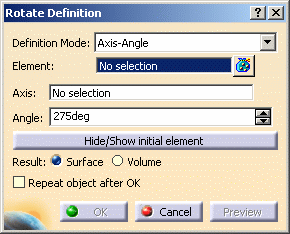Open the Transform1.CATPart document.
-
Click Rotate
 .
. -
Define the rotation type:
- Axis-Angle (default mode): the rotation axis is defined by a linear element and the angle is defined by a value that can be modified in the dialog box or in the 3D geometry (by using the manipulators).
-
Axis-Two Elements: the rotation axis is defined by a linear element and the angle is defined by two geometric elements (point, line or plane)
-
Axis/point/point: the angle between the vectors is defined by the selected points and their orthogonal projection onto the rotation axis.
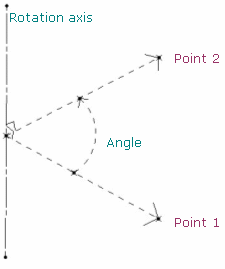
-
Axis/point/line: the angle between the vector is defined by the selected point and its orthogonal projection onto the rotation axis and the selected line.
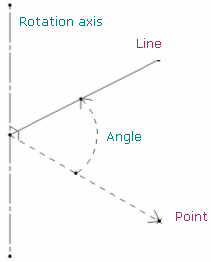
-
Axis/point/plane: the angle between the vector is defined by the selected point and its orthogonal projection onto the rotation axis and the normal to the selected plane.

-
Axis/line/line: the angle between the direction vectors of the projection is defined by the two selected lines in the plane normal to the rotation axis.
In case both lines are parallel to the rotation axis, the angle is defined by the intersection points of the plane normal to the rotation axis and these lines. 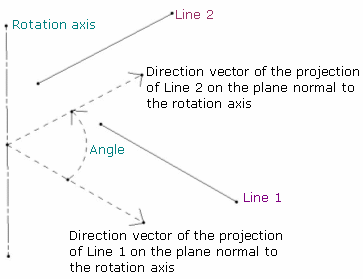
-
Axis/line/plane: the angle is defined between the selected line and the normal to the plane.
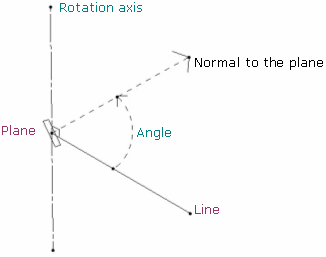
-
Axis/plane/plane: the angle is defined between the normals to the two selected planes.
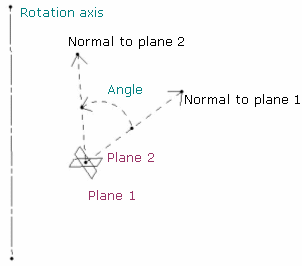
-
-
Three Points: the rotation is defined by three points.
-
The rotation axis is defined by the normal of the plane created by the three points passing through the second point.
-
The rotation angle is defined by the two vectors created by the three points (between vector Point2-Point1 and vector Point2-Point3):
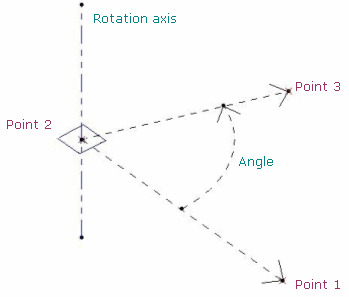
-
The orientation of the elements (lines or planes) is visualized in the 3D geometry by a red arrow. You can click the arrow to invert the orientation and the angle is automatically recomputed. By default, the arrow is displayed in the direction normal to the feature (line or plane).
For instance, in the plane/plane mode, the arrow is displayed on each plane: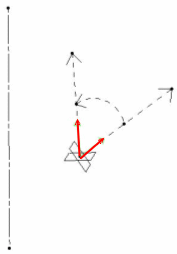
-
Select the Element to be rotated.
-
Select the inputs depending on the chosen rotation type.
-
Click OK to create the rotated element.
The element (identified as Rotate.xxx) is added to the specification tree.
Optional Parameters
- Click Hide/Show initial element to hide or show the original element for the translation.
- Choose whether you want the result of the
transformation to be a surface or a volume by switching to either
Surface or Volume option.

This capability is only available with Generative Shape Optimizer. This switch only concerns volumes since the transformation of a surface can only be a surface. Thus in case of multi-selection of volumes and surfaces, the switch only affect volumes. Note: - Replacing an input element does not change the result type,
- The switch between surface and volume is grayed out when editing the feature.
To have further information about volumes, refer to the corresponding chapter. - Check the Repeat object after OK to create several rotated
surfaces, each separated from the initial surface by a multiple of the
Angle value.
Simply indicate in the Object Repetition dialog box the number of instances that should be created and click OK. 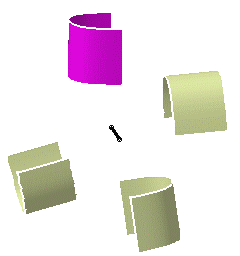

The Repeat object after OK capability is not available with the Axis-Two Elements and Three Points rotation types. - You can select an axis system as the
Element to be rotated, providing it was previously created.
The element is identified as Rotate.xxx in the specification tree, however the associated icon is the axis system's  .
.
If you select a solid as the input element, the result will either be a surface or a volume.
Note that the selection of the feature prevails over the selection of the sub-element.
To select a sub-element, you need to apply the ''Geometrical Element'' filter in the User Selection Filter toolbar.
For further information, refer to the Selecting Using A Filter chapter in the CATIA Infrastructure User's Guide.
You can edit the rotated element's parameters. Refer to Editing Parameters to find out how to display these parameters in the 3D geometry.
The following capabilities are available: Stacking Commands, Selecting Using Multi-Output, Measure Between and Measure Item.
![]()
